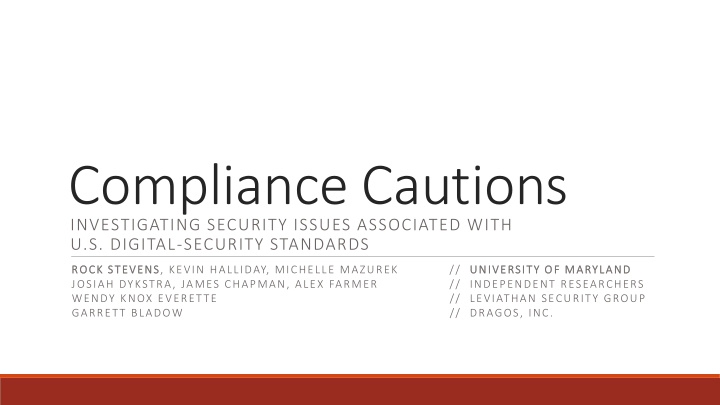



Compliance Cautions INVESTIGATING SECURITY ISSUES ASSOCIATED WITH U.S. DIGITAL-SECURITY STANDARDS ROCK CK S STEVENS, KEVIN HALLIDAY, MICHELLE MAZUREK // UNIV IVERSIT ITY O OF M MARYLAND JOSIAH DYKSTRA, JAMES CHAPMAN, ALEX FARMER // INDEPENDENT RESEARCHERS WENDY KNOX EVERETTE // LEVIATHAN SECURITY GROUP GARRETT BLADOW // DRAGOS, INC.
What are compliance standards? Series of controls or policies that establish a baseline of security
Why use compliance standards? Mandatory to provide critical services or access to sensitive data
How is it enforced? Audits Financial sanctions Privilege revocation
Vendor @ RSAC20 selling compliance
So what’s the problem? False sense of security Never intended to be used as a checklist
Even if you had First empirical evaluation of perfect compliance standards for security compliance, issues that exist because of what else could perfect compliance go wrong?
Audited Standards Internal Revenue Services Publication 1075 Payment Card Industry Data Security Standard North American Electric Reliability Corporation Critical Infrastructure Protection 007-6
Audit Our External expert evaluation methodology Disclose
Audit intent Leverage real-world experience Match to exploitation in the wild Determine root cause
Probability Unlikely Seldom Occasional Likely Frequent Catastrophic M H H E E Severity Critical L M H H E Moderate L L M M H Negligible L L L L M L ow | M edium | H igh | E xtremely High Determining risk estimates
External expert evaluation Recruited CISOs and compliance authors Validate findings Challenge our assumptions Provide additional context
Disclose findings Inform authors/councils Inform users of standards Exercise existing vuln disclosure processes
Results
Audit: By the numbers 3 standards 148 issues 4 root causes
Audit: Root causes Data vulnerability Unenforceable Under-defined process Ambiguous specification
Data vulnerability PCI DSS only protects enclave with cardholder data
Data vulnerability Electric grid standards allows for variable security based on power production levels
Unenforceable IRS P1075 requires multiple forms of physical security to protect data *and* Authorizes telework/remote access to data
Under-defined process IRS P1075 mandates a network component inventory *but* Never establishes “ground truth”
Ambiguous specification IRS P1075: access control policies to be evaluated every 3 years. By whom? PCI DSS: all issues identified during a pentest must be addressed. By when? Priority?
External expert evaluation “Checklist compliance” confirmed 36/49 issues confirmed 10 plausible 3 rejected (kinda)
Disclosure attempts Top-level reporting US-CERT National Vulnerability Database MITRE Corp Community knowledge “Each issue that requires a separate patch can get a CVE” Direct CVEs reporting
Disclosure attempts Top-level reporting NIST discussions on checklists DHS “cease communications” Community knowledge Direct CVEs reporting
Disclosure attempts Top-level reporting PCI Council made updates based on findings IRS ignored all calls/texts/emails Community knowledge Direct CVEs reporting
Recommendations Make checklists Solidify language to eliminate ambiguity Orgs should conduct self-assessments Better disclosure process
Summary Perfect compliance != perfect security ◦ Ambiguous specifications and under-defined processes ◦ Lack of reporting makes fixing known problems harder First study to empirically identify issues associated with compliance Developed methodology for assessing other frameworks > Questions / Feedback? rstevens@cs.umd.edu | @ada95ftw
Recommend
More recommend